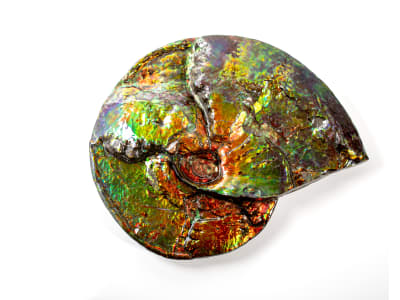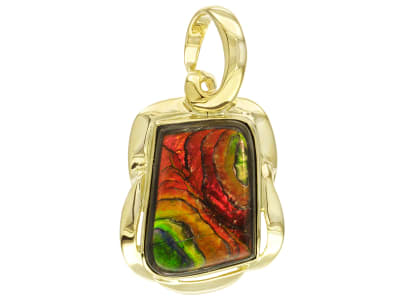Ammolite is a gem that comes from the fossilized shell of an extinct, squid-like creature called an ammonite. Found in Canada, the iridescent shell of fossilized ammonites is available as ammonite fossils or in iridescent gems cut from the fossils under the trade name ammolite. Ammolite's iridescent play of color is what makes it so distinctive and attractive. Its iridescence occurs when the fossilized ammonite shell becomes mineralized. Unlike most gems, whose colors come from light absorption, ammolite's iridescent color is caused by interference with the light that gets trapped within stacked layers of thin platelets that make up the fossilized shell. Since the layer of ammolite is typically thin, most ammolite is made into doublets or triplets for use in jewelry. A doublet is a thin slice of shell that is typically covered by a durable material (often crystal, glass or plastic) that both protect the gem and maximize its presentation. Triplets are typically assembled by placing a thin slice of shell between two layers of more durable material that are attached with epoxy. While shades of green and red are usually seen, all spectral colors are possible.
General Information
Tolerance:varies
LWUV: Inert to strong yellow
Ammolite Colors
-
 Brown
Brown -
 Green
Green -
 Multi-color
Multi-color
Alternate Names
Ammonite, Lumachelle, Calcentine
Countries of Origin
Canada; Austria; Cambodia; Unknown; Madagascar
History
Ammolite is highly iridescent and delivers light in an every-color-under-the-rainbow display. It's a gem that comes from the fossilized shell of an extinct, squid-like creature called an ammonite. The shell is a color-rich layer that is typically quite thin, so most ammolite found in jewelry is set as a doublet or triplet. Ammolite, although an ancient stone, is a relative newcomer to the jewelry scene. It emerged on the world stage as ammolite in the 1960s and was given official gemstone status by the World Jewelry Federation in 1981. There is historical evidence that suggests ammolite enjoyed popularity in amulets and talismans for centuries. One of the rarest gemstones in the world, ammolite is positioned to be a very special part of your jewelry collection.
Care
Ammolite is very soft, so be mindful of scratching. Avoid abrasives, ultrasonic, solvents and heat. Requires gentle handling.
More About Ammolite
Today ammolite is treasured by jewelry lovers. It is also important to practitioners of the ancient Chinese art of Feng Shui, where it is known as the "Seven Color Prosperity Stone." Those who subscribe to those principles believe it bestows upon its owners health, harmony, wealth, and enlightenment. The Roman historian, Pliny the Elder, called ammonite fossils the "holiest of stones". He believed ammonite would summon dreams of prophecy.


